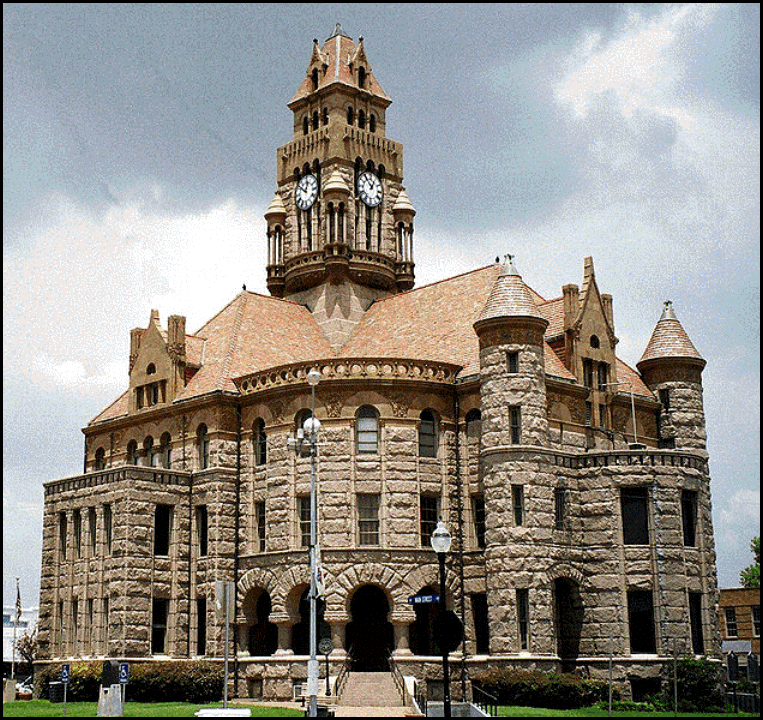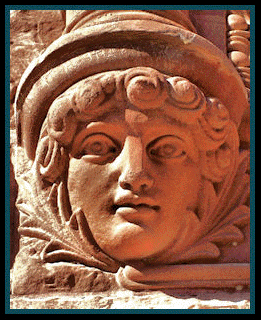His Courthouses and
Other Public Architecture
Chris Meister
(Texas Tech University Press)

- "Man if you ever go to Texas
You better watch out
Sheriff Sloan will arrest you
He will take you right out..."
And then there is your typical big Texas city. Hot as a griddle, ugly as hell. To be in downtown Dallas is to be mirrored in a cheesy penny arcade. You are there in July baking in the midday dusty sun and you're surrounded by three dozen buildings that reflect the sun back in your face, as if you weren't sweating enough, anyway.
If you have an insatiable need to suffer, you can go ... and there can be some rewards. There is always the rich cultural pot of Mexicans, Latinos, Germans, Blacks and country folk. Good music. Good chili. Noisy parties. People shooting at each other as if it were good clean fun.
It might be worthwhile just to go and visit these stupendous courthouses, twenty-one built by James Riely Gordon in the halcyon years of Romanesque civic construction that popped up at the end of the 19th century. Stay out of the blow-dry atmosphere of Houston or Dallas or Galveston or Waco or New Braunfels or Dimmitt ... and instead go to La Grange, or Stephenville, or Gonzales, or Giddings or, top of the list, Waxahachie or Victoria. To look at, be amazed by the elaborate and often very funny architecture of James Riely Gordon.
There are 254 counties in Texas which you might agree are just too damn many. Most of these can be left in the bin, especially those like Bee (county seat: Beeville), Matagorda (means "kill the fat lady," no kidding), Real (governed from the damp seat of Leakey), Jim Hogg County (governor, rancher, two daughters, "Ira" and "Ura"), Deaf Smith (named for Erastus "Deaf" Smith --- the best scout during the Texas war against the Mexicans: he couldn't hear the bullets whizzing around him). Then there's County Perdido (which actually did get lost during the "upheavals of 1840") ... and my personal favorite, Loving County: capital, Menton --- the source of the Goodnight-Loving cattle trail and I didn't make that one up either.
Forget the dimwits who make Texas their home: go see Gordon's Romanesque courthouses. A plump man he was, with the steady gaze of one who came out on top in the eye-gouging knee-in-the-groin in-fighting with old-fashioned Texas back county back-stabbing favors and commissions and outright thievery that constituted the backpocket plumtree of small town governance.
Gordon was in the middle of it during the great building boom of these astonishing wedding-cake courthouses with their hip roofs, pink granite columns, clock towers (each clock face, from Seth Thomas, giving out with a different time), the checkered friezes along roof tops, the stone filials, the gable voussoirs and tourelles in the corners, the gable points, the recessed bays, the decorations on the spandrels, the horseshoe arched porches, the balustrades.

And certainly no justice, peace, nor order except for the belly-pooched, heavy-joweled, gallus-snapping crackers who run the whole steamy cracker-whipped show there in Bay City, Eldorado, San Saba, or Sweetwater. Justice and beauty not to be had there, certainly never in Pecos. You remember the law west of the Pecos?
There are twenty-one Romanesque beauties left out there in the tules out of the forty-one that Gordon originally designed. Go to Victoria, Gonzales, Sulphur Springs, Decater, Giddings, or New Braunfels. Or hell, call up Texas Tech University Press and get a copy of James Riely Gordon. Saves you a hot muggy trip in your hot muggy car through the hot muggery that they call the Lone Star. Spare us.
And why did they do it? Why did the pinch-penny country folk of Baird and Waco and Stephenville and La Grange put themselves in debt so many years to build these babies?
Why did they do it? Because if they didn't go at it, the people in the podunk village next door would steal it out from under them. Remember, a big courthouse in your back yard was a pot of gold, a gift that kept on giving. Think of the fees, the baksheesh, the driblets of gelt here and there. The good people of Marshall knew that if they didn't grab onto this sucker, this deluxe Romanesque Gordon cathedral of power rising high there in the flat dust country, why the hillbillies of Elysian Fields or Jonesville or Nesbitt or Uncertain (Uncertain, Texas? Why not?) would steal it out from them. So they had to jump on this baby, which they did by hiring Gordon to be their designing angel.
For the hundreds of thousands they spent on this pile set there in the center of town was their ticket to survive in the bleak, bleached blighted patch-work that is that dry, half-baked Texas farm country.